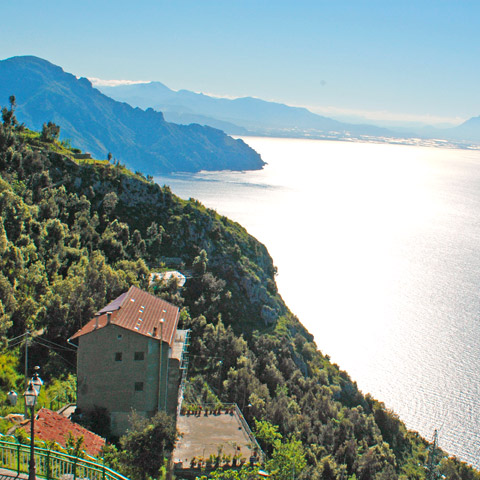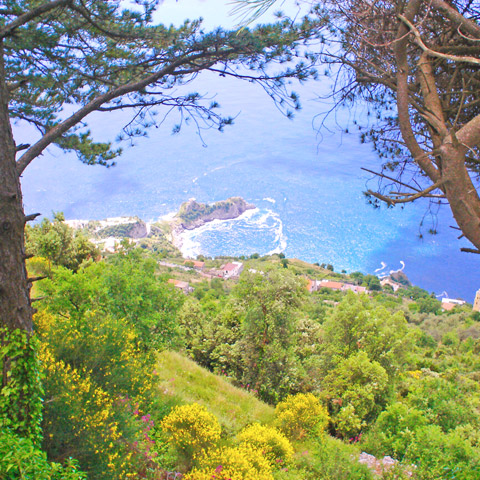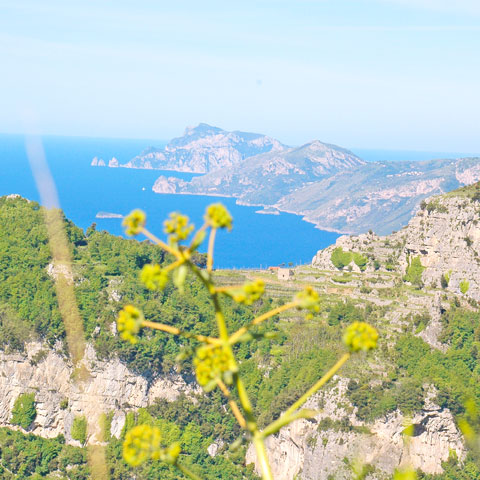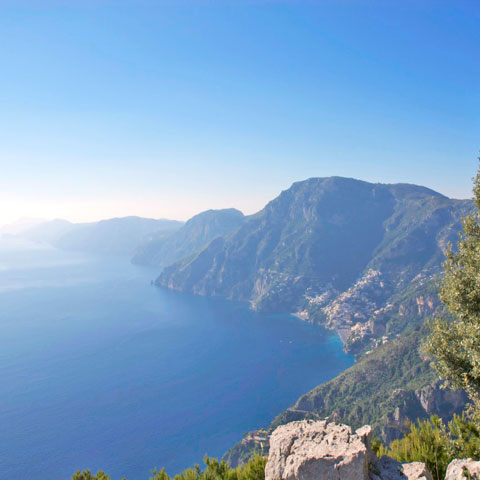Trekking on the Amalfi Coast
On the paths of the Amalfi Republic, and of the ancient Romans.
Furore is a charming town for trekking that attracts hikers of all nationalities. The hiking trails through the routes used for century by local folks of the Amalfi Coast, revive the tourist the extraordinary history of these places, once the crossroads of major trade the Republic of Amalfi with the countries of the hinterland, but also scene of legendary battles in Roman times. Furore awaits you with an unforgettable journey, accompanied by beautiful landscapes, exciting sunrises and sunsets, surrounded by the scents of the Mediterranean vegetation.
The Amalfi Coast and Monti Lattari Park offer numerous hiking trails, with the magic of colors and essences that give the seasons from spring to autumn: myrtle, carob, olive, oak, flowering ash, arbutus and heather, chestnut, alder, hornbeam, ash; they are just some of the tree species that grow along the paths.
Path of the Gods: (length 8 km) journey time 4 hours. Difficulty: It is easy with exposed sections. The path keeps within it all the charm of the name given, from Via Casalone within walking distance from the Bed & Breakfast Il Canto delle Sirene or from the square of Bomerano Paolo Capasso and leads to Positano. The information boards give indications of the route and there are reports mileage at intervals of 100 m. At the "Biscotto Cave", which takes its name from the typical bread agerolese reminiscent of the characteristic geological structure of the rock wall, there is a source of drinking water and from here you can observe some ancient ruins of houses stuck in the cave. The route passes through walls, caves, wooded sections and arched cultivated terraces; after Colle Serra, gaze rests on the enchanting view of Sorrento Peninsula until you reach the village of Nocelle (450 m. Above sea level) from where you can take a bus or walk up a flight of stairs in Positano.
Path dell'Orrido Pino: (length 5 km) from Via Casalone or from the square of Paolo Capasso in Bomerano you continue along the trail to S. Barbara, and following the path downstream of the cave of the same name( where you can admire the remains of cave dwellings and the monastery of the eleventh century AD), we arrive at the village of Furore; then walking on the road for a stretch until the Schiato path that crosses the river, near a old mill. The trail continues uphill to the hamlet of San Lazzaro di Agerola.
Path of Praia:(length 4 km) from Via Casalone or from the square of Bomerano Paolo Capasso, continuing through the trail towards S. Barbara cave where you can admire the ruins of the monastery of the same, follow the path right through the bed of the river Praia. This old trail then passes through the villages on the coast: Praiano and Vettica Maggiore. Near the church of St. Luke, you go down the staircase that leads to Cala di Rezzola.
Path of the Borgo Marinaro:(length 4 km) in the vicinity of the lookout Fausto Coppi is one of the steps that descend along the coast and it come up to the Fjord of Furore, a narrow valley carved by the river over thousands of years, where, embedded in rock, close to the beach, you can enjoy a picturesque old fishing village.
Path of the Three Calli:(lenght 6 KM DH +400/-400 m, 5 H, E) along the road that passes through the center of Bomerano the location Pendola, you reach Paipo, where you can see the ruins of the casino Paipo dating back to Bourbon. From here you go up to the saddle of Cape Wall. Then south along the ridge of the mountain Calabrice, you arrive at the Monte Tre Calli. From this area you can enjoy a spectacular view of Agerola and on the Amalfi Coast.
Path Ai Denti del Gigante:(lenght 7 KM) along the trail behind the church of St. Peter, in Pianillo, it passes through the hill called Locoli and flowing, then, because of the Upper Lattari. Continuing west, walking around the pyramid ridge of Mount St.Angelo ai Tre Pizzi , you reach the cave Holy Water. Climbing the highest peak of the three, the view of the gulfs of Naples and Salerno, Vesuvius, Ischia, Sorrento Peninsula and Capri with its Faraglioni.
Trail of Sources:(lenght 5 KM, DH+400/-400m; T) Starting point: 650 m above sea level. Arrival point for trekkers experts, about 1000 m. Above sea level Duration: 3 hours (short course), 5 hours (full path). The trail crosses paths originate from water sources. The first section of the trail starts from the village of Campora, near the source of water Leggia, and continues along the river Penise, through a lush valley of chestnut trees. Continuing along the path you look at the remains of the Bourbon Powder XVIIIsec. It is possible to reach the sources Fiubana, St. Julian's, Cold Water and Water Vracciara source of high mountain, about 1000 meters above sea level, from here you can enjoy a magnificent view of the bay of Naples and Vesuvius.
Top of the Monte Sparviero(lenght 5 KM, DH+400/-400m; T) along an old mule stepped from the piazza of S. Martin, Campora, up the rocky ridge, the resort Pontechito you can enjoy a breathtaking view over the entire valley of Agerola. Crossing the old chestnut woods, you arrive at Cima del Monte Sparviero e Colle delle Vene. From the top the view is across the deep and steep Valle delle Ferriere, Amalfi, Ravello and farther, the Gulf of Salerno.
Path of the Old Republic: (lenght 4 KM) Near the viewpoint of S.Lazzaro there are some stairs that go through the village of Tovere and come to Vettica Minor.
Path of Dawn: (lenght 4KM)from the center of S. Lazzaro it continues along the scenic route to Radicosa, then along an old mule stepped leading up to the Monte Murillo, and then go around to the south-east. It therefore comes in the Valley Vocito and looking back to the south you will come to the ruins of the medieval monastery of Cospita.
Path of Valle delle Ferriere: :(5 h; E) from the center of San Lazzaro, continuing Radicosa you take the trail that goes halfway under the M.Murillo until you reach the trail to Pogerola, along a rocky path, a descent steep climb up the side of the valley up to the beautiful waterfalls and the Nature Reserve of Valle delle Ferriere where it grows an endemic species of fern dating from the Tertiary, the Woodwardia radicans, and which can be accessed by requesting permission from the Forest Service State. You can continue the descent to Amalfi, admiring along the way, the ruins of the ancient foundries and paper mills in the Valley of the Mills which made famous the production of Amalfi paper.




